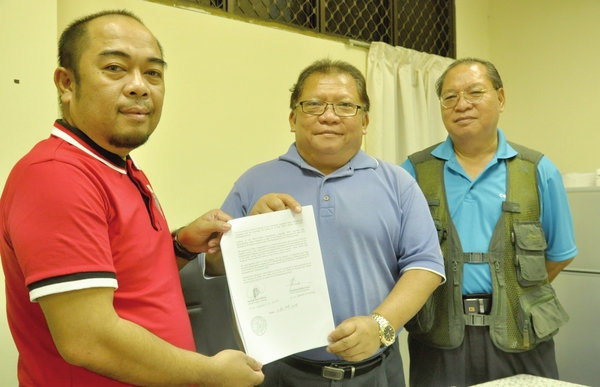KDCA, USDA defend use of Bundu-Liwan
Published on: Thursday, October 18, 2018

Penampang: Kadazandusun Cultural Association (KDCA) and United Sabah Dusun Association (USDA) have defended the use of Bundu-Liwan for teaching in schools, saying the central dialect has a majority of speakers in the Kadazandusun language family.The two major Kadazandusun language stakeholder associations said this was established by linguistic experts, especially the Summer Institute of Linguistics (SIL), an organisation that serves language communities worldwide, that identified Bundu-Liwan as having high "intelligibility" compared with other dialects in the Kadazandusunic and Paitanic speaking groups.The SIL, way back in 1991, had estimated that there were about 70,000 speakers of the Bundu dialect.
ADVERTISEMENT
"We maintain that Bundu and Liwan are both dialects and mother tongues in their own manner and they fulfil the criteria definition of mother tongue in our socio-cultural context as the first language, native language or mother tongue/father/parent tongue that the Bundu and/or Liwans had been exposed to since their birth being of Bundu and/or Liwan ethnicity within the larger Kadazandusun community," read a joint statement by the two associations.The statement was issued after a meeting between association presidents, Tan Sri Joseph Pairin Kitingan of KDCA and Datuk Dr Ewon Ebin of USDA, recently.The two leaders met in response to a statement made by educationalist, Evelyn Annol, who claimed that Bundu-Liwan is not a proper language and its use for the teaching in schools is against the Education Act 1996 (Act 550). "It is not a pure mother tongue of any race in Sabah. It's a mixture of dialects," she was quoted as saying, recently.
ADVERTISEMENT
She had disagreed with Deputy Chief Minister Datuk Seri Wilfred Madius Tangau who, in an earlier statement, had said that there must not be any confusion about what ethnic language to be used as the standard and official Kadazandusun language to be taught in school as it had been agreed by both associations three decades ago to use Bundu-Liwan.Evelyn, who said she was also part of the panel directly involved in designing the curriculum, this came to be known after some "hidden documents" came to light soon after the 14th General Election.
ADVERTISEMENT
She claimed that the documents would prove that Bundu-Liwan language "should not have been used from the very beginning because its teachings are against the Education Act." Instead, she pointed out that what should have been taught in schools are mother tongues such as Kadazan, Dusun, Rungus, Kimaragang, Iranun, Murut and others.On her claims of the existence of the "hidden documents", KDCA and USDA said they need to avail them as basis to resolve the issue of illegality, if any.But the associations could not take Evelyn's claim that Bundu-Liwan is not a pure mother tongue."To say that Bundu-Liwan does not exist is sheer arrogance and disrespectful to the Liwan and Bundu communities, and it's highly questionable of a senior educationalist's attitude," they said.They also said they were surprised by Evelyn's claim its teaching in schools is against the Education Act as neither the Education Ministry nor department has ever brought up the subject of illegality."While we were aware of the requirement for parents of at least 15 students in a school to request for the teaching of any ethnic language as Pupil's Own Language (POL), we looked at it then as a general request of the Kadazandusun community whose multi-dialectical languages have fairly high intelligibility although at varying degrees," they argued. They further maintained that although Bundu and Liwan are individually distinguishable as dialects by themselves from the two Dusunic language mother tongue cognates, when combined, they can be regarded as a dialect that is clearly distinguishable from other major dialects of the Kadazandusunic language especially in relation to the Kadazan Tangaa' dialect.The associations pointed out that the Kadazan Tangaa' consists of fricatives 'v' and 'z' and the implosive 'b' and 'd' but these are absent in the Dusun language that consists of 'w', 'y' and 'r' instead, similarly with Bundu-Liwan dialect.KDCA and USDA also pointed out that within the Dusunic language family, Bundu and Liwan are the two largest groups which were referred to as "central Dusun" by the SIL in their language survey in 1980.In the survey, the organisation indicated that the major Dusun speaking areas were Tambunan, Keningau, Ranau, Kota Belud, Tamparuli, Kiulu, Telipok, Menggatal, Inanam, Upper Moyog, and Upper Papar.One research done in 2007 had also established that Bundu Dusun is a dialect of central Dusun which is an Austronesian language spoken mainly in Sabah.The associations added that the reasons for choosing Bundu-Liwan is well explained in a Memorandum of Understanding between the KDCA and USDA in 1995.However, they said that nothing in the MoU prevents any Kadazandusun ethnic community to apply to the Education Ministry for their own language to be taught in school based on the Education Act 550 (1996).Stay up-to-date by following Daily Express’s Telegram channel.
Daily Express Malaysia




